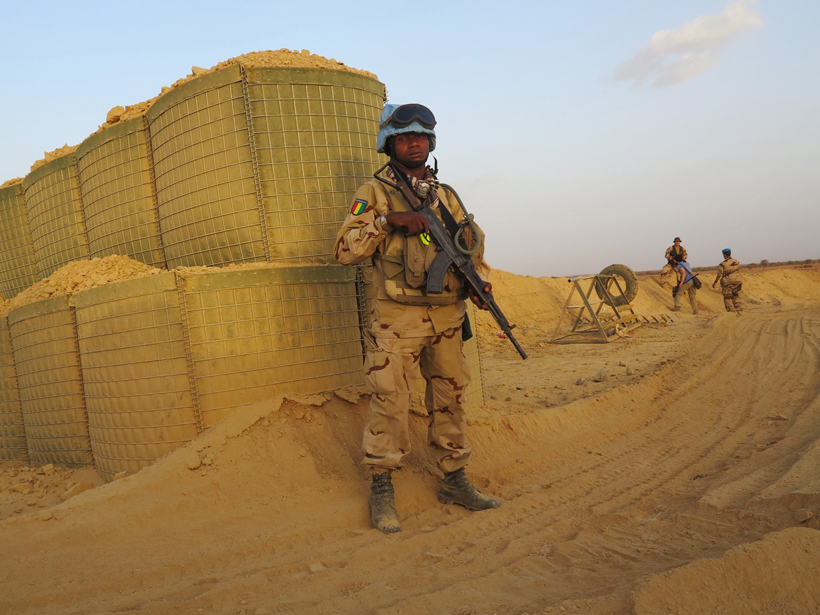A new U.S. presidential memorandum cites the threats of climate change to national security and establishes a policy requiring that current and anticipated climate change–related impacts “are fully considered in the development of national security doctrine, policies, and plans.”
The memorandum, issued by the White House on Wednesday, creates a federal Climate and National Security Working Group led by staff from the National Security Council and the White House Office of Science and Technology Policy (OSTP). The directive calls for the working group to develop within 90 days an action plan to identify, assess, and share information about climate-related impacts on national security. It also requires federal agencies to respond to the action plan by developing implementation plans within 150 days.
The new policy “is the most comprehensive approach ever taken by the U.S. government to identify and act on climate change–related impacts of natural security interest.”
The new policy “is the most comprehensive approach ever taken by the U.S. government to identify and act on climate change–related impacts of natural security interest,” Brian Deese, senior adviser to the president, said at a 21 September briefing.
National Intelligence Council Report
The White House issued a related report, “Implications for US National Security of Anticipated Climate Change,” prepared by the National Intelligence Council (NIC). The report outlines ways that climate change can affect national security, including instability of countries hit by climate-induced “disruptions” such as drought and subsequent famine or other weather-related disasters. Climate change could also heighten social and political tensions due to decreases in water, access to farmland, and population migrations; could lead to boundary disputes related to the warming and opening of the Arctic Ocean; and could stress military operations and coastal military bases, the report notes.
During the next 5 years, national security risks linked to climate change “will mostly arise from distinct extreme weather events,” especially in countries with weak governance, poor living conditions, or conflict, according to the report. In the next 20 years, however, climate change also will play out in broader and more systemic ways as a result of more acidic oceans, rising sea levels, and other threats that will result in “sustained direct and indirect effects on US national security.”
Long-Lasting Impact of the New Policy?
The release of the new policy, which builds on earlier planning laid out in documents such as a 2015 U.S. National Security Strategy, marks “the first time that the intelligence community is delineating pathways” for determining when and where climate change impacts concretely affect U.S. national security interests, Deese noted at the briefing.
The memorandum will have a long-lasting impact beyond the Obama administration, predicted White House science adviser John Holdren, who chairs OSTP.
“There is every reason for the next administration to follow this blueprint,” Holdren said at the briefing. “The facts on the ground, in the atmosphere, and in the oceans are not going to change. In fact, the impacts of climate change on national security are only going to grow.”
Decreasing the Chance of Being Caught Off Guard
The memorandum “elevates attention to the risks of climate change to the highest levels of national security planning, which is a critical step in ensuring that our national response is commensurate to the risk,” Francesco Femia, cofounder and copresident of the Center for Climate and Security, told Eos. The center is a Washington, D. C.–based think tank with an advisory board of senior military and national security experts.
The memorandum, along with the National Intelligence Council report, “decreases the chances that we’ll be caught off guard by security risks driven or exacerbated by climate change.”
Femia added that the issue of climate change and national security has been of concern to the intelligence and military communities across administrations. The memorandum, along with the NIC report, “decreases the chances that we’ll be caught off guard by security risks driven or exacerbated by climate change,” he said. “That will help us be better prepared, both in the civilian and military sectors.”
The U.S. National Academies are organizing a public webinar—on a date not yet announced when this article went to publication—with briefings about the memorandum on climate change and national security.
—Randy Showstack, Staff Writer
Citation:
Showstack, R. (2016), White House: National security plans must consider climate risks, Eos, 97, https://doi.org/10.1029/2016EO059899. Published on 23 September 2016.
Text © 2016. The authors. CC BY-NC-ND 3.0
Except where otherwise noted, images are subject to copyright. Any reuse without express permission from the copyright owner is prohibited.

